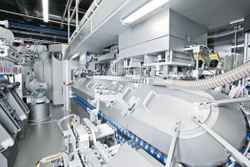
Posted to News on 17th May 2012, 14:53
TFS 80-8 tube-filling machine uses Festo automation technology
Festo technology is used in a machine that fills toothpaste tubes at the unprecedented rate of 750 per minute, making it the fastest in the world

Germany company OYSTAR IWK designs and manufactures an extensive range of tube filling machines, together with complementary tube feeding and cartoning machines. Their new TFS 80-8 uses Festo automation technology extensively: all its pneumatic drives are controlled by CPX/MPA valve terminals, and an MS6-SV soft-start/quick exhaust valve is used to protect both the machine and its operators.
The 8-stage TFS 80-8 tube filling machine accommodates tubes with diameters up to 28mm and is capable of filling and closing 750 tubes a minute. This is equivalent to 45,000 tubes an hour. At the end of the process, a high speed SC 3-800 cartoning machine packs the 750 tubes into attractive pre-printed boxes.
Although the TFS 80-8 has a similar footprint to the company's previous model, which could handle up to 510 tubes per minute, its throughput is nearly 50 per cent higher. The new machine also reduces overfilling of the tubes by precisely checking their weight. Over a year, this can save as much as 83,000kg of toothpaste.
The machine combines state-of-the-art control electronics with a Festo MS6-SV soft-start/quick exhaust valve, connected upstream to a traditional 5/3-way directional control valve. Easily meeting the requirements of Machinery Directive 2006/42/EC, this ensures safe system start-up and guarantees correct exhausting in both emergency and non-emergency situations. The TFS 80-8 has two synchronised robots, and uses a dual circuit pneumatic design to ensure that tubes are fed in correctly. All the machine's pneumatic drives are controlled by an MPA valve terminal, while all sensor signals are processed by CPX valve terminal input modules. Festo's CPX/MPA valve terminals and MS-6 series safety valves have been defined as long-term standards by the OYSTAR group.
In the first step of the process that leads to the "perfect' tube of toothpaste, a robot feeds empty tubes, which are open at the bottom, to the tube holder. The edge of the tube is checked for possible defects by a high-resolution camera, and the tube is then opened up using compressed air, while a second camera monitors the process.
Precise alignment of tubes
The TFS-80 precisely aligns each tube by detecting a mark printed on its surface, and then ensures that the tube remains in the correct position throughout the process and retains a stable shape when it is filled. Any misalignment could cause the printed design to appear askew or shifted once the tube has been closed. The machine also reads the code printed on the tube, so that each tube is allocated to the correct production batch. This enables customers to see clearly where a tube delivery came from, and on which day it was filled.
If a predefined number of errors occur within a specific period, indicating a production problem, the machine stops automatically and the operators are prompted to investigate the source of the error. Reject tubes are clearly identified and do not impair the overall quality of the batch.
The TFS-80's filling module distributes the toothpaste inside the tube. A 3/2-way directional control valve sucks in the correct volume, redirects it and discharges it. A plunger opens the filling pipe, the toothpaste flows into the tube, the filling pipe closes again and the plunger cuts off the supply of toothpaste. Each filling point has a weighing station that feeds data back to the machine's control system. This enables the amount of toothpaste in each tube to be controlled very precisely, preventing overfilling.
Once the tube has been filled, its open end is heated by hot air. Care is taken to ensure that the hot air does not come into direct contact with the toothpaste or affect the tube's aluminium layer, otherwise it might leak. As soon as the material reaches the correct temperature, a press closes the tube and embosses its seam. The end of the tube is then neatly severed by the machine's cutting station.
Cyclical to continuous operation
Further down the line, another machine station discards reject tubes. Good tubes travel on to the discharge point where they are ejected from the holder and rotated 180 degrees. After the finished toothpaste tubes have been weighed again, the machine places them onto the continuously running product chain of the next machine in the line, which is the cartoning machine. This is a critical point in the process, because it is here that the machine's mode of operation changes from cyclical to continuous; the associated mechanical components are specially designed to accommodate very high acceleration rates and the movement of large masses.
At the end of the line, folding cartons are opened up automatically, aligned and brought up to the same speed as the tubes that are running in parallel. A special pusher finger pushes each tube gently into its carton, which is then closed. Safely and hygienically filled, checked and packed in attractive outer packaging, the tubes are now ready for delivery.
For more information about Festo's pneumatic and electrical automation technology, visit the website at www.festo.com.






























